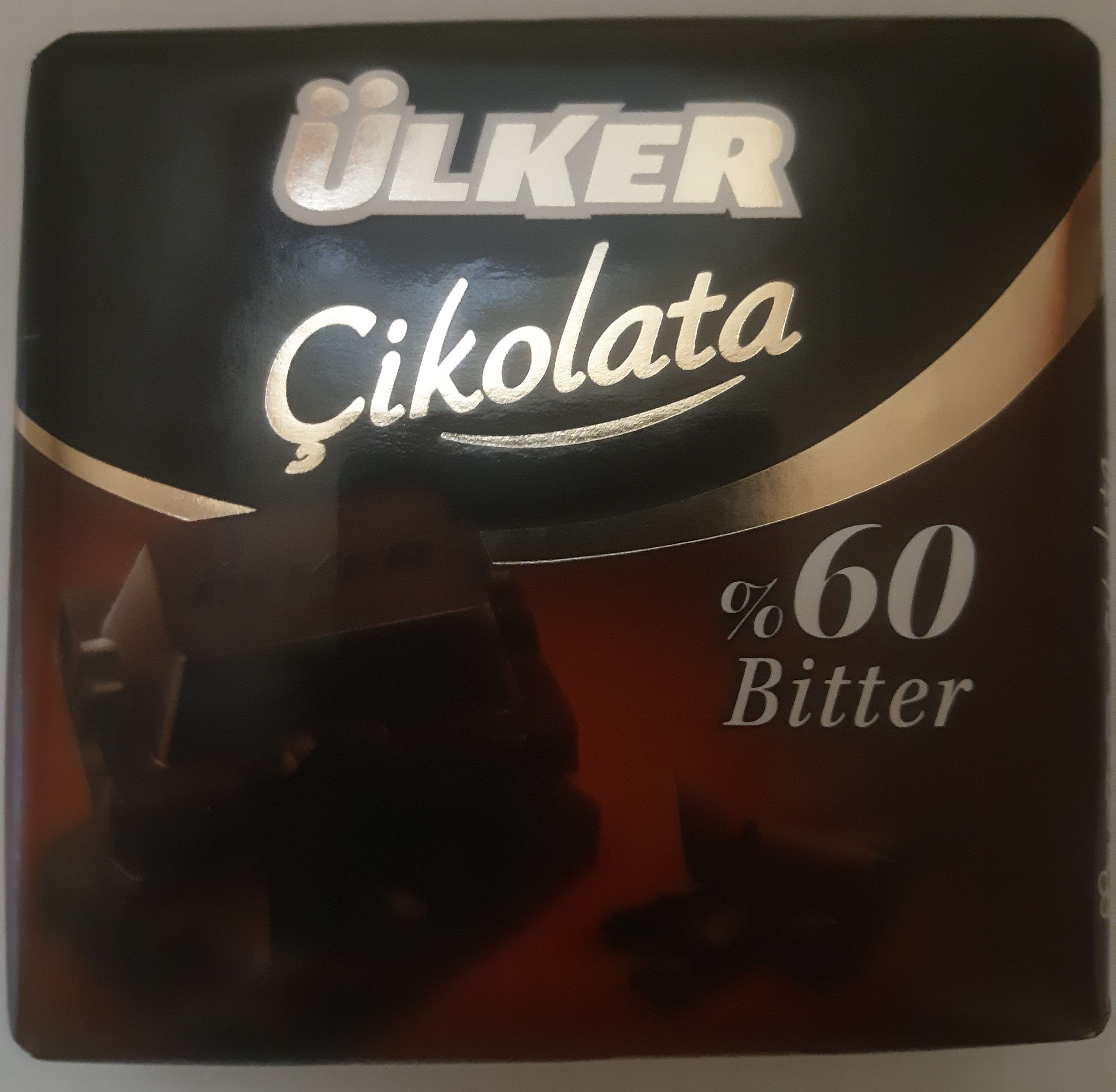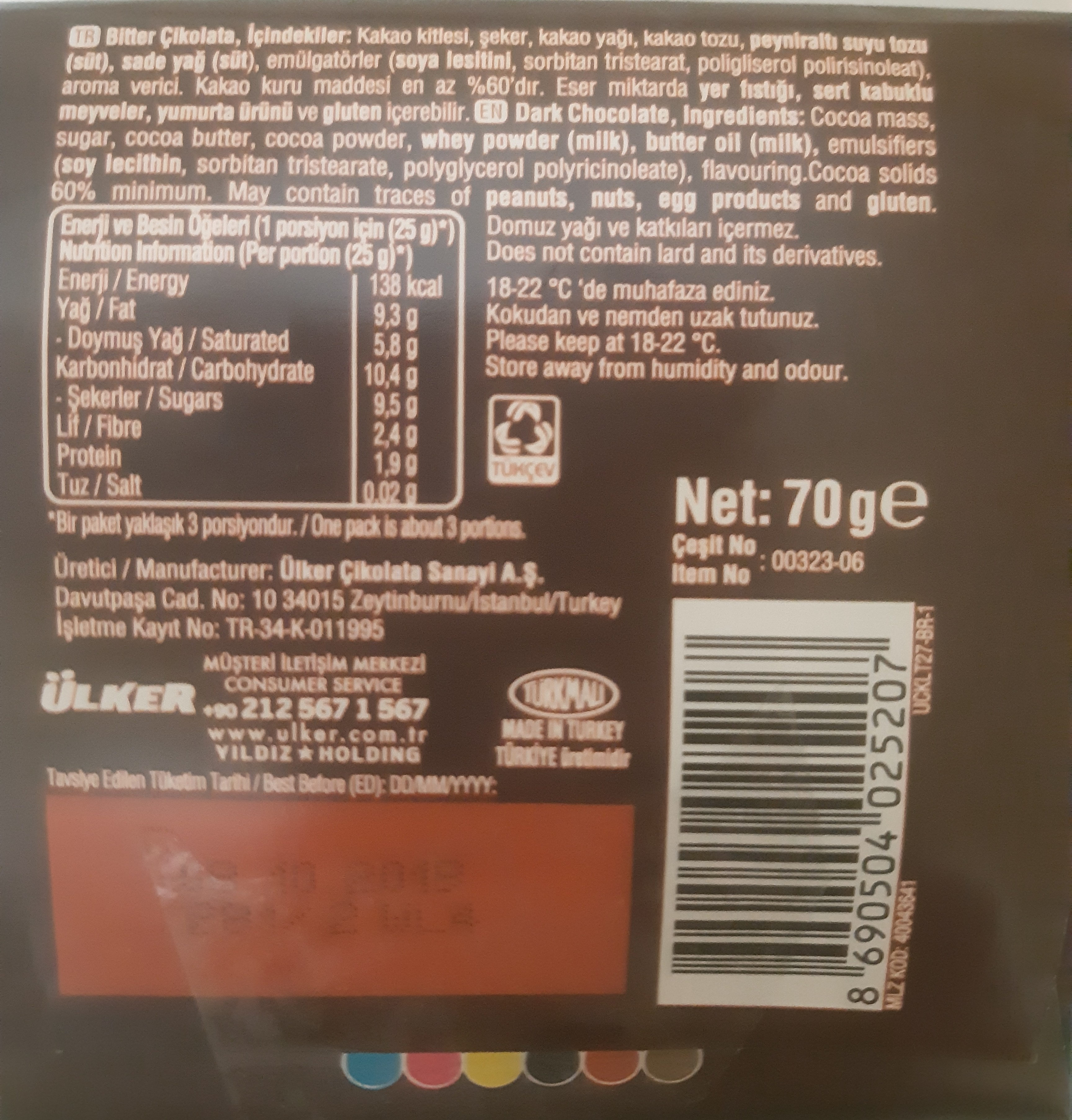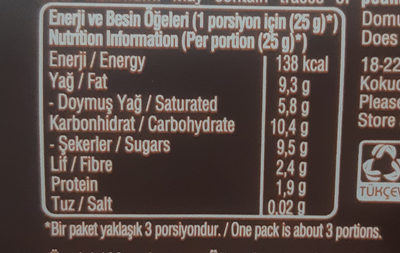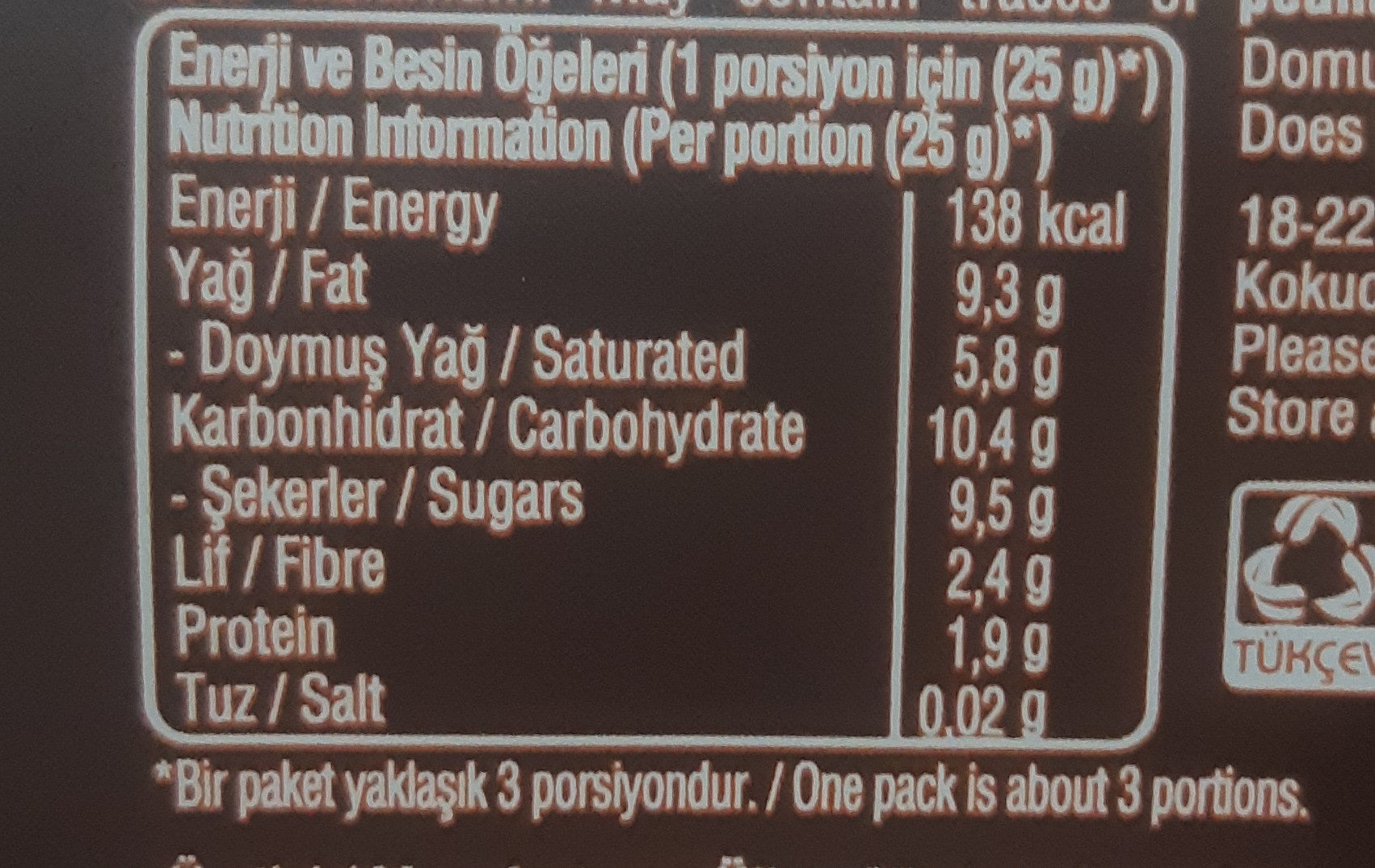Gıda şeffaflığını bir norm haline getirmemize yardımcı olun!
Kâr amacı gütmeyen bir kuruluş olarak, dünyanın dört bir yanındaki tüketicileri ne yedikleri konusunda bilgilendirmeye devam etmek için bağışlarınıza güveniyoruz.
Gıda devrimi sizinle başlıyor!
Bitter Çikolata - ülker - 70g
Bitter Çikolata - ülker - 70g
Bu ürün sayfası tamamlanmadı. Düzenleyerek ve elimizdeki fotoğraflardan daha fazla veri ekleyerek, ya da Android veya iPhone/iPad uygulamalarını kullanarak daha fazla fotoğraf çekerek tamamlanmasına yardım edebilirsiniz. Teşekkürler!
×
Barkod: 8690504025207 (EAN / EAN-13)
Miktar: 70g
Ambalaj: en:Paper package
Markalar: Ülker
Kategoriler: Atıştırmalıklar, en:Sweet snacks, Kakao ve kakao ürünleri, Çikolatalar, Bitter çikolata, en:Extra fine dark chocolates
Etiketler, sertifikalar, ödüller: en:Ülker çikolata bitter
Malzemelerin kaynağı: Türkiye
Üretim veya işleme yerleri: Istanbul
İzlenebilirlik kodu: TR EAN 13
Üreticinin resmi sitesinde ki ürün bağlantı adresini sağlayın: http://www.ulker.com.tr
Mağazalar: Supermarkets
Satılan ülkeler: Kıbrıs Cumhuriyeti, Almanya, Türkiye, Amerika Birleşik Devletleri
Tercihlerinizle eşleştirme
Sağlık
İçindekiler
-
11 bileşen
TR Bitter Çikolata, Içindekiler: Kakao kitlesi, şeker, kakao yağı, kakao tozu, peyniralti suyu tozu (sut), sade yağ (süt), emülgatörler (soya lesitini, sorbitan tristearat, poligliserol polirisinoleat), aroma vericiAlerjenler: en:Milk, en:SoybeansIzler: en:Gluten, en:Nuts, en:egg-products, en:may-contain-traces-of-peanuts
Gıda işleme
-
Üst düzey işlemden geçmiş yiyecekler
Ürünün Çok işlenmiş gıdalar grubunda olduğunu gösteren unsurlar:
- Katkı maddesi: E322
- Katkı maddesi: E476
- Katkı maddesi: E492
- Bileşen: Emulsifier
- Bileşen: Flavouring
- Bileşen: Peynir altı suyu
Gıda ürünleri işlenme derecelerine göre 4 gruba ayrılır:
- İşlenmemiş veya az işlenmiş gıdalar
- İşlenmiş yemek malzemeleri
- İşlenmiş gıdalar
- Üst düzey işlemden geçmiş yiyecekler
Grubun belirlenmesi, ürünün kategorisine ve içerdiği bileşenlere göre yapılır.
Katkı maddeleri
-
E322
Lecithin: Lecithin -UK: , US: , from the Greek lekithos, "egg yolk"- is a generic term to designate any group of yellow-brownish fatty substances occurring in animal and plant tissues, which are amphiphilic – they attract both water and fatty substances -and so are both hydrophilic and lipophilic-, and are used for smoothing food textures, dissolving powders -emulsifying-, homogenizing liquid mixtures, and repelling sticking materials.Lecithins are mixtures of glycerophospholipids including phosphatidylcholine, phosphatidylethanolamine, phosphatidylinositol, phosphatidylserine, and phosphatidic acid.Lecithin was first isolated in 1845 by the French chemist and pharmacist Theodore Gobley. In 1850, he named the phosphatidylcholine lécithine. Gobley originally isolated lecithin from egg yolk—λέκιθος lekithos is "egg yolk" in Ancient Greek—and established the complete chemical formula of phosphatidylcholine in 1874; in between, he had demonstrated the presence of lecithin in a variety of biological matters, including venous blood, in human lungs, bile, human brain tissue, fish eggs, fish roe, and chicken and sheep brain. Lecithin can easily be extracted chemically using solvents such as hexane, ethanol, acetone, petroleum ether, benzene, etc., or extraction can be done mechanically. It is usually available from sources such as soybeans, eggs, milk, marine sources, rapeseed, cottonseed, and sunflower. It has low solubility in water, but is an excellent emulsifier. In aqueous solution, its phospholipids can form either liposomes, bilayer sheets, micelles, or lamellar structures, depending on hydration and temperature. This results in a type of surfactant that usually is classified as amphipathic. Lecithin is sold as a food additive and dietary supplement. In cooking, it is sometimes used as an emulsifier and to prevent sticking, for example in nonstick cooking spray.Bilgi Kaynağı: Wikipedia (İngilizce)
-
E322i - Lesitin
Lecithin: Lecithin -UK: , US: , from the Greek lekithos, "egg yolk"- is a generic term to designate any group of yellow-brownish fatty substances occurring in animal and plant tissues, which are amphiphilic – they attract both water and fatty substances -and so are both hydrophilic and lipophilic-, and are used for smoothing food textures, dissolving powders -emulsifying-, homogenizing liquid mixtures, and repelling sticking materials.Lecithins are mixtures of glycerophospholipids including phosphatidylcholine, phosphatidylethanolamine, phosphatidylinositol, phosphatidylserine, and phosphatidic acid.Lecithin was first isolated in 1845 by the French chemist and pharmacist Theodore Gobley. In 1850, he named the phosphatidylcholine lécithine. Gobley originally isolated lecithin from egg yolk—λέκιθος lekithos is "egg yolk" in Ancient Greek—and established the complete chemical formula of phosphatidylcholine in 1874; in between, he had demonstrated the presence of lecithin in a variety of biological matters, including venous blood, in human lungs, bile, human brain tissue, fish eggs, fish roe, and chicken and sheep brain. Lecithin can easily be extracted chemically using solvents such as hexane, ethanol, acetone, petroleum ether, benzene, etc., or extraction can be done mechanically. It is usually available from sources such as soybeans, eggs, milk, marine sources, rapeseed, cottonseed, and sunflower. It has low solubility in water, but is an excellent emulsifier. In aqueous solution, its phospholipids can form either liposomes, bilayer sheets, micelles, or lamellar structures, depending on hydration and temperature. This results in a type of surfactant that usually is classified as amphipathic. Lecithin is sold as a food additive and dietary supplement. In cooking, it is sometimes used as an emulsifier and to prevent sticking, for example in nonstick cooking spray.Bilgi Kaynağı: Wikipedia (İngilizce)
-
E476
Polyglycerol polyricinoleate: Polyglycerol polyricinoleate -PGPR-, E476, is an emulsifier made from glycerol and fatty acids -usually from castor bean, but also from soybean oil-. In chocolate, compound chocolate and similar coatings, PGPR is mainly used with another substance like lecithin to reduce viscosity. It is used at low levels -below 0.5%-, and works by decreasing the friction between the solid particles -e.g. cacao, sugar, milk- in molten chocolate, reducing the yield stress so that it flows more easily, approaching the behaviour of a Newtonian fluid. It can also be used as an emulsifier in spreads and in salad dressings, or to improve the texture of baked goods. It is made up of a short chain of glycerol molecules connected by ether bonds, with ricinoleic acid side chains connected by ester bonds. PGPR is a yellowish, viscous liquid, and is strongly lipophilic: it is soluble in fats and oils and insoluble in water and ethanol.Bilgi Kaynağı: Wikipedia (İngilizce)
-
E492
Sorbitan tristearate: Sorbitan tristearate is a nonionic surfactant. It is variously used as a dispersing agent, emulsifier, and stabilizer, in food and in aerosol sprays. As a food additive, it has the E number E492. Brand names for polysorbates include Alkest, Canarcel, and Span. The consistency of sorbitan tristearate is waxy; its color is light cream to tan.Bilgi Kaynağı: Wikipedia (İngilizce)
Malzeme analizi
-
Hurma yağı içerebilir
Hurma yağı içerebilecek malzemeler: en:Butterfat
-
Vegan değil
Vegan olmayan malzemeler: Peynir altı suyu tozu, en:Butterfat
-
Vejetaryen olabilir
Vejetaryen olmayabilecek içerikler: Peynir altı suyu tozu, E492, en:Flavouring
-
İçerik analizlerinin detayları
: cocoa mass, sugar, cocoa butter, cocoa powder, whey powder, butter oil, emulsifiers (soy lecithin, sorbitan tristearate, polyglycerol polyricinoleate), flavouring- cocoa mass -> en:cocoa-paste - vegan: yes - vegetarian: yes - ciqual_proxy_food_code: 16030 - percent_min: 12.5 - percent_max: 100
- sugar -> en:sugar - vegan: yes - vegetarian: yes - ciqual_proxy_food_code: 31016 - percent_min: 0 - percent_max: 38
- cocoa butter -> en:cocoa-butter - vegan: yes - vegetarian: yes - ciqual_food_code: 16030 - percent_min: 0 - percent_max: 33.3333333333333
- cocoa powder -> en:cocoa-powder - vegan: yes - vegetarian: yes - ciqual_food_code: 18100 - percent_min: 0 - percent_max: 25
- whey powder -> en:whey-powder - vegan: no - vegetarian: maybe - percent_min: 0 - percent_max: 20
- butter oil -> en:butterfat - vegan: no - vegetarian: yes - from_palm_oil: maybe - ciqual_food_code: 16401 - percent_min: 0 - percent_max: 16.6666666666667
- emulsifiers -> en:emulsifier - percent_min: 0 - percent_max: 14.2857142857143
- soy lecithin -> en:soya-lecithin - vegan: yes - vegetarian: yes - ciqual_food_code: 42200 - percent_min: 0 - percent_max: 14.2857142857143
- sorbitan tristearate -> en:e492 - vegan: maybe - vegetarian: maybe - percent_min: 0 - percent_max: 7.14285714285714
- polyglycerol polyricinoleate -> en:e476 - vegan: yes - vegetarian: yes - percent_min: 0 - percent_max: 4.76190476190476
- flavouring -> en:flavouring - vegan: maybe - vegetarian: maybe - percent_min: 0 - percent_max: 5
Beslenme
-
Çok kötü beslenme kalitesi
⚠ ️Uyarı: Meyve, sebze ve kuruyemiş miktarı etikette belirtilmemiştir, içindekiler listesinden tahmin edilmiştir: 0Bu ürün, Nutri-Score hesaplaması için bir içecek kabul edilmemektedir.
Pozitif puanlar: 5
- Proteinler: 4 / 5 (değer: 7.6, yuvarlanmış değer: 7.6)
- Lif: 5 / 5 (değer: 9.6, yuvarlanmış değer: 9.6)
- Meyve, sebze, kuruyemiş ve kolza/ceviz/ zeytin yağı: 0 / 5 (değer: 0, yuvarlanmış değer: 0)
Negatif puanlar: 24
- Enerji: 6 / 10 (değer: 2310, yuvarlanmış değer: 2310)
- Şeker: 8 / 10 (değer: 38, yuvarlanmış değer: 38)
- Doymuş yağ: 10 / 10 (değer: 23.2, yuvarlanmış değer: 23.2)
- Sodyum: 0 / 10 (değer: 32, yuvarlanmış değer: 32)
Negatif puanlar 11'e eşit veya fazla olduğu için proteinler için olan puanlar dahil edilmedi.
Beslenme puanı: (24 - 5)
Nutri-Score:
-
Besin seviyeleri
-
Yağ içinde yüksek miktarda (37.2%)
Bilmeniz gerekenler- Yüksek yağ tüketimi, özellikle doymuş yağlar, kalp hastalığı riskini artıran kolesterolü yükseltebilir.
Öneri: Yağ ve doymuş yağ tüketimini azaltın- Daha az yağ ve doymuş yağ içeriği olan ürünleri seçin.
Bilgi Kaynağı: National Health Service UK (NHS) - Fat: the facts
-
Saturated fat içinde yüksek miktarda (23.2%)
Bilmeniz gerekenler- Yüksek yağ tüketimi, özellikle doymuş yağlar, kalp hastalığı riskini artıran kolesterolü yükseltebilir.
Öneri: Yağ ve doymuş yağ tüketimini azaltın- Daha az yağ ve doymuş yağ içeriği olan ürünleri seçin.
Bilgi Kaynağı: National Health Service UK (NHS) - Fat: the facts
-
Şeker içinde yüksek miktarda (38%)
Bilmeniz gerekenler- Yüksek şeker tüketimi kilo alımına ve diş çürümelerine neden olabilir. Aynı zamanda tip 2 diyabet ve kardiyovasküler hastalık riskini artırır.
Öneri: Şeker ve şekerli içeceklerin tüketimini sınırlayın- Şekerli içecekler (gazlı içecekler, meyveli içecekler, meyve suları ve nektarlar gibi) mümkün olduğu kadar sınırlandırılmalıdır (günde 1 bardaktan fazla olmamalıdır).
- Şeker oranı düşük ürünleri tercih edin ve ilave şeker içeren ürünlerin tüketimini azaltın.
Bilgi Kaynağı: National Health Service UK (NHS) - Sugar: the facts
-
Yemek tuzu içinde düşük miktar (0.08%)
Bilmeniz gerekenler- Yüksek miktarda tuz (veya sodyum) tüketimi, kalp hastalığı ve felç riskini artırabilen kan basıncının yükselmesine neden olabilir.
- Yüksek tansiyonu olan birçok kişi sahip olduğunu bilmiyor çünkü çoğunlukla hiçbir belirtisi olmuyor.
- Çoğu insan çok fazla tuz tüketir (günde ortalama 9 ila 12 gram), bu da önerilen maksimum alım seviyesinin yaklaşık iki katıdır.
Öneri: Tuz ve tuzlu yiyecek tüketimini sınırlayın- Yemek pişirirken kullanılan tuz miktarını azaltın ve sofrada bir daha tuz atmayın.
- Tuzlu atıştırmalıkların tüketimini sınırlayın ve daha az tuz içeren ürünleri seçin.
Bilgi Kaynağı: National Health Service UK (NHS) - Salt: the facts
-
-
Beslenme gerçekleri
Beslenme gerçekleri Satıldığı gibi
100 g / 100 ml içinSatıldığı gibi
porsiyon başına (25g)Nazaran: en:Sweet snacks Enerji 2.310 kj
(552 kcal)577 kj
(138 kcal)+%13 Yağ 37,2 g 9,3 g +%46 Saturated fat 23,2 g 5,8 g +%178 Karbonhidratlar 41,8 g 10,45 g -%20 Şeker 38 g 9,5 g +%58 Fiber 9,6 g 2,4 g Protein 7,6 g 1,9 g -%3 Yemek tuzu 0,08 g 0,02 g -%81 Alkol 0 % vol 0 % vol Fruits‚ vegetables‚ nuts and rapeseed‚ walnut and olive oils (estimate from ingredients list analysis) 0 % 0 %
Çevre
-
Eco-Score C - Orta düzeyde çevresel etki
Eco-Score gıda ürünlerinin çevresel etkilerini özetleyen deneysel bir puandır.→ Eco-Score başlangıçta Fransa için geliştirildi ve diğer Avrupa ülkelerine de yayılıyor. Eco-Score formülü, her ülke için daha kesin ve daha uygun hale getirmek üzere düzenli olarak geliştirildiğinden değişebilir.Yaşam döngüsü analizi
-
Aynı kategorideki ürünlerin ortalama etkisi: D (Score: 35/100)
Kategori: Dark chocolate bar, filled with praline
Kategori: Dark chocolate bar, filled with praline
- PEF çevre puanı: 0.89 (puan ne kadar düşükse, etki o kadar düşük olur)
- iklim değişikliği üzerindeki etki dahil: 17.11 kg CO2 eşdeğeri/kg ürün
Sahne Etki Tarım
14.3 %İşleme
81.0 %Ambalaj
1.2 %Taşıma
3.0 %Dağıtım
0.5 %Tüketim
0.0 %
Bonuslar ve kötüye kullanımlar
-
Orta etkili bileşenlerin kökenleri
Bonus: +6
Çevre politikası: -5
Taşıma: +11
Ürünün ve/veya bileşenlerinin menşei içeriklerin yüzdesi Etki Türkiye 100 %Orta
-
Düşük etkili paketleme
Malus: -1
Şekil Malzeme Geri Dönüşüm Etki Paket 22 PAP Düşük
Bu ürün için Eko-Skor
-
Bu ürün için etki: C (Score: 40/100)
Ürün: Bitter Çikolata - ülker - 70g
Yaşam döngüsü analizi puanı: 35
Bonusların ve kötü kullanımların toplamı: +5
Son skor: 40/100
-
Karbon Ayakizi
-
Benzinli bir arabayla 8.9 km gitmeye eşittir
100 g ürün başına 1711 g CO²
karbon emisyonu sayısı ADEME'nin Agribalyse veritabanından aşağıdaki kategori için türetilmiştir: Dark chocolate bar, filled with praline (Kaynak: ADEME Agribalyse Veritabanı)
Sahne Etki Tarım
8.6 %İşleme
89.2 %Ambalaj
0.6 %Taşıma
1.6 %Dağıtım
0.1 %Tüketim
0.0 %
Ambalaj
-
Düşük etkili paketleme
-
Ambalaj parçaları
Paket (22 PAP)
-
Ambalaj malzemeleri
Malzeme % Ambalaj ağırlığı 100 g ürün başına ambalaj ağırlığı Paper or cardboard
-
Taşıma
-
Bileşenlerin kökenleri
Orta etkili bileşenlerin kökenleri
Ürünün ve/veya bileşenlerinin menşei içeriklerin yüzdesi Etki Türkiye 100 %Orta
Report a problem
-
Incomplete or incorrect information?
Category, labels, ingredients, allergens, nutritional information, photos etc.
If the information does not match the information on the packaging, please complete or correct it. Open Food Facts is a collaborative database, and every contribution is useful for all.
Veri kaynakları
Üzerinde ürün eklendi tarafından openfoodfacts-contributors
Ürün sayfasının son düzenlemesi tarafından packbot.
Ürün sayfasını da düzenleyen aleene, inf.










